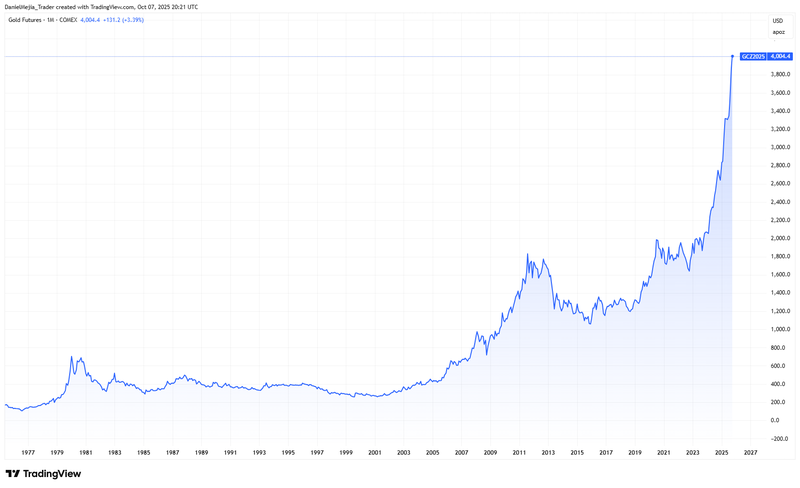Gold rallies to $4,000 record during US shutdown
Today's report focuses on relevant financial and political developments. The gold futures contract (GCZ5) reached $4,000 per ounce for the first time in its history, reflecting investors' continued search for safe-haven assets. Meanwhile, the government shutdown in the US continues due to Congress failing to reach a federal budget deal, complicating forecasts for the Fed's next decision.

Gold prices reached $4,000 per ounce, representing an approximate 51% increase Year-to-Date (YTD).
The US government shutdown continues, with President Donald Trump threatening cuts to federal programmes and jobs.
Oil futures contracts recovered after the OPEC+ production increase was announced to be below estimates.
The Henry Hub natural gas contract increased by 4.3% after Ukraine announced higher imports due to shortages.
Gold futures hit $4,000 per ounce
The gold futures contract (GCZ5) reached $4,000 per ounce for the first time in its history (see Figure 1), representing an increase of 0.71% at today's close. This level represents a Year-to-Date (YTD) increase of approximately 51%.
Investors' search for refuge remains constant amid a scenario of widespread political and economic uncertainty. The convergence of political instability in the US, France, and Japan has generated nervousness among investors who were already pricing in likely policy changes by influential central banks such as the Federal Reserve (Fed) and the Bank of Japan (BoJ).
However, constantly updated information is leading to abrupt changes in forecasts. On the one hand, the rise of Sanae Takaichi to the leadership of the Liberal Democratic Party raises expectations that an expansionary policy will be promoted in Japan, should she secure the position of prime minister. On the other hand, the US government shutdown, which has been prolonged because Democrats and Republicans cannot agree on federal funding, generates uncertainty regarding the Fed's next policy decisions. As a result, estimates suggest that the BoJ could curb its monetary tightening intentions, while the Fed could keep its benchmark rates unchanged in the absence of economic data.

Figure 1. GCZ5 Gold Futures Contract (1976-2025). Source: data from Comex Exchange, image obtained from TradingView.
Government shutdown continues as Trump suggests funding cuts
According to information from Reuters and CNBC, US President Donald Trump has stated that government programmes will be cut during the shutdown and that some furloughed federal employees may not receive their retroactive salaries. In addition, there is a possibility that federal payrolls will be cut. Information on cuts to jobs and programmes could be released in four or five days, according to President Trump's statements.
Additionally, according to Reuters, the White House is considering cancelling an additional $12 billion in clean energy funding. This not only reflects the intentions of the current government regarding the reduction of public spending, but it also stands in stark contrast to the energy transition that previous administrations were promoting.
Oil prices recover on OPEC+ caution
The Brent (BRNZ5) and WTI (CLX5) futures contracts have accumulated a recovery of 2% from their low of the previous week after OPEC+ confirmed a smaller production increase than analysts had estimated. Brent reached $65.45 per barrel, while WTI closed near $61.75 per barrel. During its last meeting, the Organisation of the Petroleum Exporting Countries (OPEC+) decided to increase its production by 137,000 barrels per day starting in November, a figure below traders' expectations.
Meanwhile, the price of the Henry Hub Natural Gas (NGX5) futures contract increased by 4.3% at market close, after Ukraine announced its intention to increase natural gas imports by 30%. The contract reached a level of $3.50 per unit. Although the price of natural gas has accumulated an increase of approximately 33% since its August low, it has not yet reached its break-even point for the year, with a cumulative loss of 3.7% since January 2025.
